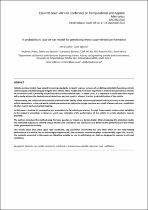JavaScript is disabled for your browser. Some features of this site may not work without it.
- ResearchSpace
- →
- Research Publications/Outputs
- →
- Conference Publications
- →
- View Item
| dc.contributor.author |
Clarke, Anria

|
|
| dc.contributor.author |
Sabatta, D

|
|
| dc.date.accessioned | 2018-10-26T09:47:37Z | |
| dc.date.available | 2018-10-26T09:47:37Z | |
| dc.date.issued | 2018-09 | |
| dc.identifier.citation | Clarke, A. and Sabatta, D. 2018. A probabilistic quarter-car model for predicting worst-case vehicle performance. Eleventh South African Conference on Computational and Applied Mechanics (SACAM 2018), Vanderbijlpark, South Africa, 17-19 September 2018 | en_US |
| dc.identifier.uri | https://www.vut.ac.za/sacam2018/#1502791011790-fdff0ba6-6d10 | |
| dc.identifier.uri | http://hdl.handle.net/10204/10505 | |
| dc.description | Paper presented at the 11th South African Conference on Computational and Applied Mechanics (SACAM 2018), Vanderbijlpark, South Africa, 17-19 September 2018 | en_US |
| dc.description.abstract | Vehicle preview models have gained increasing popularity in recent years as a means of predicting potentially hazardous vehicle control inputs and attempting to mitigate their effects. These models are even more important in the field of autonomous vehicles as the vehicle itself is providing the potentially hazardous control input. In these cases, it is important to verify that these inputs will actually achieve the desired control objectives, and not result in a loss of traction or destabilisation of the vehicle. Unfortunately, the validity of these models is limited by the fidelity of the mathematical model and the accuracy of the estimated vehicle parameters. In the real-world, vehicle parameters are subject to change over time as a result of wear-and-tear, installation of after-market parts and vehicle loading. In this paper a method for propagating any uncertainty in the vehicle parameters through these models to determine variability in the output is presented. In doing so, worst-case estimates of the performance of the vehicle in certain situations may be provided. The authors introduce this method using the basic quarter-car model as a demonstrator. After developing the statistical model, the estimated outputs are verified using a Monte Carlo simulation, and conclusions are drawn on the performance of the vehicle under parameter uncertainty. The results show that under ideal road conditions, any parameter uncertainty has very little effect on the road-holding performance of a vehicle, but on increasingly rougher roads, this parameter uncertainty plays a substantially larger role. As such, the methods presented in this paper are therefore suitable for use in self-driving cars that are designed to operate in off-road conditions. | en_US |
| dc.language.iso | en | en_US |
| dc.relation.ispartofseries | Worklist;21581 | |
| dc.subject | Quarter-car model | en_US |
| dc.subject | Stochastic mechanics | en_US |
| dc.subject | Autonomous vehicle | en_US |
| dc.subject | Dynamic load coefficient | en_US |
| dc.title | A probabilistic quarter-car model for predicting worst-case vehicle performance | en_US |
| dc.type | Conference Presentation | en_US |
| dc.identifier.apacitation | Clarke, A., & Sabatta, D. (2018). A probabilistic quarter-car model for predicting worst-case vehicle performance. http://hdl.handle.net/10204/10505 | en_ZA |
| dc.identifier.chicagocitation | Clarke, Anria, and D Sabatta. "A probabilistic quarter-car model for predicting worst-case vehicle performance." (2018): http://hdl.handle.net/10204/10505 | en_ZA |
| dc.identifier.vancouvercitation | Clarke A, Sabatta D, A probabilistic quarter-car model for predicting worst-case vehicle performance; 2018. http://hdl.handle.net/10204/10505 . | en_ZA |
| dc.identifier.ris | TY - Conference Presentation AU - Clarke, Anria AU - Sabatta, D AB - Vehicle preview models have gained increasing popularity in recent years as a means of predicting potentially hazardous vehicle control inputs and attempting to mitigate their effects. These models are even more important in the field of autonomous vehicles as the vehicle itself is providing the potentially hazardous control input. In these cases, it is important to verify that these inputs will actually achieve the desired control objectives, and not result in a loss of traction or destabilisation of the vehicle. Unfortunately, the validity of these models is limited by the fidelity of the mathematical model and the accuracy of the estimated vehicle parameters. In the real-world, vehicle parameters are subject to change over time as a result of wear-and-tear, installation of after-market parts and vehicle loading. In this paper a method for propagating any uncertainty in the vehicle parameters through these models to determine variability in the output is presented. In doing so, worst-case estimates of the performance of the vehicle in certain situations may be provided. The authors introduce this method using the basic quarter-car model as a demonstrator. After developing the statistical model, the estimated outputs are verified using a Monte Carlo simulation, and conclusions are drawn on the performance of the vehicle under parameter uncertainty. The results show that under ideal road conditions, any parameter uncertainty has very little effect on the road-holding performance of a vehicle, but on increasingly rougher roads, this parameter uncertainty plays a substantially larger role. As such, the methods presented in this paper are therefore suitable for use in self-driving cars that are designed to operate in off-road conditions. DA - 2018-09 DB - ResearchSpace DP - CSIR KW - Quarter-car model KW - Stochastic mechanics KW - Autonomous vehicle KW - Dynamic load coefficient LK - https://researchspace.csir.co.za PY - 2018 T1 - A probabilistic quarter-car model for predicting worst-case vehicle performance TI - A probabilistic quarter-car model for predicting worst-case vehicle performance UR - http://hdl.handle.net/10204/10505 ER - | en_ZA |






